
TOPICS

TOPICS
Barak Armored Brigade
The Barak Brigade is one of the regular armored brigades of the Northern Command. The Barak Brigade was formed before the establishment of the State of Israel, when it was known as the Carmeli Brigade. It was then an infantry brigade which fought in the north of Israel, from the Western Galilee to kibbutz Manara.
Today, the brigade's symbol is that of the Carmeli brigade, which has been used since the brigade was established. After the establishment of the State, all the independent Jewish fighting units were dismantled, the
IDF was created and the Carmeli brigade became the "18th Brigade". During the Sinai Campaign, the brigade was deployed on the Jordanian border, and therefore did not have an active role in the combat. One of the main conclusions after the war was that the army needed armored units, and the 18th Brigade started the changeover by becoming "the 45th Armored Brigade".
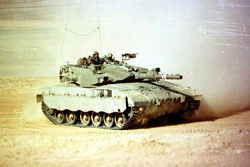 The
brigade commander, Moshe Bar-Kochba (Brill) commanded the brigade in the Six Day
War. The brigade received the Eastern sector. The IDF took the initiative to
attack, in order to remove the threat of the Long Tom guns on the valley
settlements and on the Ramat David airfield. The brigade fought a number of
bloody battles in the Dotan Valley, which ended with the blowing up of the
Jordan river bridges.
The
brigade commander, Moshe Bar-Kochba (Brill) commanded the brigade in the Six Day
War. The brigade received the Eastern sector. The IDF took the initiative to
attack, in order to remove the threat of the Long Tom guns on the valley
settlements and on the Ramat David airfield. The brigade fought a number of
bloody battles in the Dotan Valley, which ended with the blowing up of the
Jordan river bridges.
At the start of the 1970s, the brigade participated in armored attacks on terrorist bases in South Lebanon and Syria.
The experiences of the brigade during the Yom Kippur War in 1973 were particularly difficult. At the time, the Barak brigade was the only regular armored force on the Golan Heights. In the light of intelligence reports, the 7th Armored Division was sent to the Golan Heights two days before the outbreak of hostilities. However, the 7th Division soldiers were not familiar with the Golan Heights. The two brigades were spread out is isolated teams along the border line. The Barak brigade was responsible for the Southern Golan Heights sector. The main Syrian efforts to break through the border was in the Southern Golan Heights area, and the ratio of defenders to attackers forces was extremely unfavorable.
During the Yom Kippur War, 112 soldiers from the Barak brigade were killed in action. After the war the brigade rebuilt itself and later participated in the Litani Campaign and other armored operations.
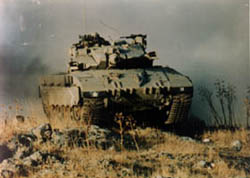
In the Peace for Galilee War, the brigade led division forces into Lebanon. This war was in built-up areas, hardly the typical combat arena for armor. The brigade fought in the Beirut sector, and participated in the capture of the airport. It then continued to fight in the eastern sector in Lebanon. The brigade participated in all subsequent redeployments stabilizing the lines in the Lebanese sector, and was among the last forces to leave Lebanon.
Similar to the past, today the brigade is responsible for defending the northern sector of the Golan Heights and participates in ongoing security operations in Judea, Samaria and Lebanon.
In recent years, the brigade has changed over from the Centurion tank, which it used for an entire generation, to the ultramodern Merkava Mark 3 main battle tank. This changeover to the best combat tank in the world today has just been completed.
From the 18th Infantry Brigade to 45th Armored Brigade - The Six Day War
The Barak brigade was established in 1956 as an infantry brigade know as the 18th Brigade. When the IDF entered the Sinai Campaign, the 18th Brigade was faced with the challenge of blocking any Jordanian efforts to open a "second front". This role primarily involved patrolling along the border.
After the Sinai Campaign, the changeover process from an infantry to an armored brigade was begun. The brigade received a new designation – the 45th Armored Brigade - and was composed of one tank battalion, two armored infantry battalions, reconnaissance unit and a mortar battalion. The changeover was completed in 1962.
In November 1966, Lieutenant Colonel (at the time) Moshe Bar Kochba (Brill) received command of the brigade, and he led it during the Six Day War.
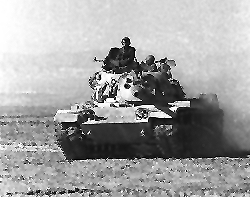 On
June 5, 1967, towards evening, the brigade broke through the border northern
part of the Samarian Hills, with the intention of removing the Jordanian
long-range artillery threat on the Ramat David Airbase. A large enemy force was
deployed in the sector into which the brigade broke through. The force was
composed mostly of Jordanian troops with some Egyptian commandos. The brigade
broke through on two axes, with the main effort placed in the direction of the
town of Jenin, and the other in the direction of the Um-el-Fahem area. The
brigade came under heavy artillery and tank-gun fire.Yet the brigade advanced
and cleared the area quickly of all enemy resistance. The following day, one of
the brigade's forces entered Jenin from the direction of the Dotan Valley, and
other forces gained control of the dominating ridges for to secure the area.
During the battle, in which the Jordanian troops put up strong resistance and
showed a high level of professionalism, the Jordanian front-line
"Patton" battalion was destroyed, together with many infantry forces.
In the evening, the Jordanians quickly sent their crack 40th Armored Brigade to
the sector, which gained control of the Dotan Valley.
On
June 5, 1967, towards evening, the brigade broke through the border northern
part of the Samarian Hills, with the intention of removing the Jordanian
long-range artillery threat on the Ramat David Airbase. A large enemy force was
deployed in the sector into which the brigade broke through. The force was
composed mostly of Jordanian troops with some Egyptian commandos. The brigade
broke through on two axes, with the main effort placed in the direction of the
town of Jenin, and the other in the direction of the Um-el-Fahem area. The
brigade came under heavy artillery and tank-gun fire.Yet the brigade advanced
and cleared the area quickly of all enemy resistance. The following day, one of
the brigade's forces entered Jenin from the direction of the Dotan Valley, and
other forces gained control of the dominating ridges for to secure the area.
During the battle, in which the Jordanian troops put up strong resistance and
showed a high level of professionalism, the Jordanian front-line
"Patton" battalion was destroyed, together with many infantry forces.
In the evening, the Jordanians quickly sent their crack 40th Armored Brigade to
the sector, which gained control of the Dotan Valley.
During the day, the Barak brigade fought a hard and cruel battle in the Dotan Valley, in hilly, difficult terrain scattered with orchards and built-up areas. The combat was characterized by massive fire, maneuver and assault.
For 24 hours, the outnumbered Barak Brigade reserve force, equipped with limited materiel, faced 120 enemy "Patton" tanks and other large scale enemy forces. During the day, the Jordanian's fighting ability was broken and they went into retreat. The brigade gained control of the area and blew up the Damia bridge across the Jordan river.
On June 9th, the brigade was taken into combat on the Golan Heights and conquered the Banias heights: Hamra, Nuhila, Abassiya, Massada and Tel Jith. After this, they joined up with other forces east of Kantara, on Damascus road. On June 11th, the brigade deployed to defend the Golan Heights area.
Between Two Wars: Operations "Kalachat" and "Kiton"
In April 1969, after the brigade was moved from Mansura camp to Pilon camp, it underwent an upgrading process and its name was changed to the 188th Armored Brigade. Gradually, it was modified into a regular brigade, relpacing its old "Sherman" tanks with powerful pattern. It become the main operations arm of the northern command for combat in the War of Attrition which followed the victory of the Six Day War for 3 years. On May 12th 1970, the brigade participated in a raid in Lebanon to clean up the Fatah land area. At the time, it was the most complex and difficult tank operation in mountainous terrain ever to have been performed by the IDF and it was a test not only for the brigade, but for the whole armored corps. The excellent performance of the brigade in this operation, which was called Kalachat, was praised by the Chief of the General Staff and the GOC Northern Command general.
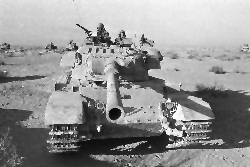 The
brigade was never allowed to rest for long. Not sooner was operation Kalachat
completed than the Operation Kiton operation began. In June, the Syrians
threatened the cease-fire line. The height of their aggression was on June 25th,
when they opened artillery fire along the line and tried to attack two IDF
posts. The Barak brigade was responsible for responding to the Syrians, with an
infiltration in the southern sector of the Heights. A day of fighting ensued,
after which the brigade penetrated the Syrian fortified lay-out and fought
against Syrian tanks. The end result was extensive losses of both men and
equipment to the enemy. After these two operations, there was relative quiet
along the borders with Syria and Lebanon. However, at the start of 1972,
fighting renewed, particularly in the Lebanese area. Once again, the brigade
went into Lebanon, and once again the many terrorist bases were destroyed. There
were also two more days of battle with the Syrians, and the achievements of the
young brigade earned for itself the reputation as a unit capable of formulating
new combat doctrines in mountainous terrain; a unit which did not hesitate to
employ innovative methods to achieve perfection.
The
brigade was never allowed to rest for long. Not sooner was operation Kalachat
completed than the Operation Kiton operation began. In June, the Syrians
threatened the cease-fire line. The height of their aggression was on June 25th,
when they opened artillery fire along the line and tried to attack two IDF
posts. The Barak brigade was responsible for responding to the Syrians, with an
infiltration in the southern sector of the Heights. A day of fighting ensued,
after which the brigade penetrated the Syrian fortified lay-out and fought
against Syrian tanks. The end result was extensive losses of both men and
equipment to the enemy. After these two operations, there was relative quiet
along the borders with Syria and Lebanon. However, at the start of 1972,
fighting renewed, particularly in the Lebanese area. Once again, the brigade
went into Lebanon, and once again the many terrorist bases were destroyed. There
were also two more days of battle with the Syrians, and the achievements of the
young brigade earned for itself the reputation as a unit capable of formulating
new combat doctrines in mountainous terrain; a unit which did not hesitate to
employ innovative methods to achieve perfection.
The Yom Kippur War
In this war, Barak Brigade's operations became part of military history. The brigade suffered heavy losses, to the point that it was almost wiped out. However, it rose from the ashes to become the IDF spearhead into the enclave which threatened Damascus.
Before the outbreak of the war, the front line on the Golan Heights, covering approximately 80 km from Mount Hermon in the north to Ramat Magshimim in the south, was the responsibility of the brigade. Up until the afternoon of the first day of battle when reserve forces arrived, the brigade, together with another regular force, was the only Israeli armored force to face the Syrian attack.
The Yom Kippur opened with a surprise attack, the enemy far outnumbering the Israeli forces in manpower and equipment. At 13.50, reports were received that enemy aircraft had penetrated the whole length of the front. These aircraft began to bomb IDF positions on the Golan Heights. The commander of the brigade, Colonel Yitzhak Ben-Shaham, ordered all his tanks to advance and make contact with the enemy.
Almost 1,200 Syrian tanks, supported by artillery and infantry, broke through the border on the Golan at a number of points. Their main efforts were in the direction of Hushniye-Sindiana-Nafah, in the southern sector. For five days, from Saturday to Wednesday, cruel and bitter battles were fought on the small area of the Golan Heights. On Saturday night, it was decided to divide up the defending forces. Responsibility for the northern sector was given to another tank brigade, while the southern sector remained the responsibility of Barak Brigade, which received a small reinforcement force. The tank forces in the northern Golan Heights, together with forces from battalion 74 and battalion 71, succeeded in preventing the Syrians from breaking through the Kunetra-Masada line. However, in the southern sector, characterized by flat terrain and lacking any natural defenses, the Syrians succeeded in breaking through. For two days, hard and bloody battles were fought to halt the attack. On Sunday afternoon, Syrian tanks reached the area of Nafah. The actual base was practically deserted, held by a small group of forces trying to get the brigade command bunker back in working order. This small group did not succeed in holding back the massive enemy force.
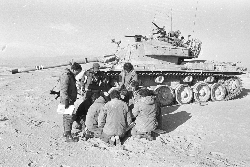 On the afternoon of October 7th, the message "A
Syrian force is breaking through at Nafah. It is already
at the fences" was received in the brigade
commander's tank. The brigade commander knew that if the
Syrians captured Nafah, not only would the largest army
base in the Golan Heights have fallen, but also he and
his forces would be encircled by the enemy. He
immediately transmitted an order to the 5 tanks in his
immediately vicinity to advance and come to the aid of
Nafah. The brigade commander, his deputy and the brigade
operations officer were killed in the breakthrough
attempt. A single tank, commanded by armored corpsman
"Zvika" who had previously fought alone on the
TAP line, and has succeeded in hitting many Syrian
tanks. In an outflanking movement, it penetrated the
camp, ran amok between the buildings firing its machine
gun in every direction, until the last of the Syrian
infantry were either killed or retreated.
On the afternoon of October 7th, the message "A
Syrian force is breaking through at Nafah. It is already
at the fences" was received in the brigade
commander's tank. The brigade commander knew that if the
Syrians captured Nafah, not only would the largest army
base in the Golan Heights have fallen, but also he and
his forces would be encircled by the enemy. He
immediately transmitted an order to the 5 tanks in his
immediately vicinity to advance and come to the aid of
Nafah. The brigade commander, his deputy and the brigade
operations officer were killed in the breakthrough
attempt. A single tank, commanded by armored corpsman
"Zvika" who had previously fought alone on the
TAP line, and has succeeded in hitting many Syrian
tanks. In an outflanking movement, it penetrated the
camp, ran amok between the buildings firing its machine
gun in every direction, until the last of the Syrian
infantry were either killed or retreated.
At the same time, a reserve unit tank force arrived and drove back the Syrians to their lines. At 3.00 in the afternoon, the Nafah camp was once again in IDF hands, and the Syrian attempt at a deep penetration of the Golan Heights had been foiled.
On Tuesday and Wednesday, the Syrians were pushed back over the border. Throughout this time, the brigade organized forces from tanks that had been hit and repaired, sending them back into battle. On Wednesday, it was the brigade's tanks, under the command of another brigade, which opened fire on the border line and first broke through into Syrian territory, in the Jubeta el Hashab village. The fighters of the brigade, who during the war stood opposite the Syrian tanks in order to prevent the enemy from utilizing their quantitative advantage and breaking through the lines, now reorganized to participate in the war of attrition. The Barak brigade were the last IDF troops to leave the Syrian enclave.
Operation Litani
Following this brutal action, the Barak brigade entered the area of South
Lebanon on 16 March. During one week, the brigade forces raided the area,
destroying terrorist bases, cleansing villages and removing the terrorists' hold
on the area.
After 3 weeks in the area, the forces of the brigade returned to their bases
in the Golan Heights.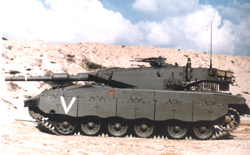 On
Saturday, 11 March 1978, two civilian buses traveling along the coastal road
were attacked by terrorists who had landed on the beach near Kibbutz Ma'agan
Michael. On the arrival of the police and the army, the terrorists blew up the
buses, killing an injuring dozens of people.
On
Saturday, 11 March 1978, two civilian buses traveling along the coastal road
were attacked by terrorists who had landed on the beach near Kibbutz Ma'agan
Michael. On the arrival of the police and the army, the terrorists blew up the
buses, killing an injuring dozens of people.
The Peace for Galilee War
The Barak brigade was among the first troops in the Peace for Galilee war. Initially, the brigade broke through the border into Lebanon into the central sector, an area similar in structure and terrain to the upper Galilee in Israel and inhabited by a number of different communities, primarily Shiite Muslims and Christians. From there, the main effort of the war moved to the western sector along the very narrow coastal plain from Sidon to Beirut, an area densely populated by Sunite Muslims.
The geographic and demographic characteristics of the sectors in which the brigade fought - densely populated on the one hand and large areas of intensely - cultivated agricultural land on the other - made regular military combat difficult and facilitated guerrilla warfare. Under these conditions, it was particularly difficult to wage conventional tank warfare. The combat in Lebanon was based on fighting in built-up areas, with close cooperation between tank, infantry, engineering and artillery gun forces.
The mission of the brigade was to destroy the terrorists bases in Lebanon, thereby removing the constant threat on the Israel's northern villages.
On Sunday, 6 June, the brigade crossed the international border in the Metulla area and started its advance north into the central sector, along the road leading to the Akia bridge on the Litani river via Taiba and Dir Sirian. The force advanced in a brigade column led by a company of the 53rd battalion, followed by the 71st battalion and the brigade advance command group led by the brigade commander. The rear elements of this force were the 12th Golani infantry battalion and the rest of the 53rd battalion companies. Engineering and anti-aircraft troops were alternated along the brigade column. The brigade's 74th battalion moved along a parallel route, under the command of a Golani brigade. The forces crossed the bridge almost without difficulty, led by the 71st battalion, passing through a number of friendly villages and continuing north.
The first encounter was at Kfar Haruf, where machine guns and RPG's were fired at the forces. The high level of ethics of our soldiers was first exhibited at this village, where they endangered their lives and prevented firing on innocent civilians. The first injuries suffered by the brigade were in this village.
While the doctor was still busy rescuing the injured and after release from the jam created in the village, the forces continued to bypass the village of A-Kafpur and secured themselves on the ridges above the village. The terrain was difficult for movement, but the problems were overcome with the help of the engineering corps.
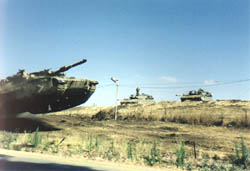
The forces continued past the village of Ha bosh, climbing in the direction of the village of Homein-el-Fawka. Heavy firing was experienced when passing this village. However, the brigade commander decided against going into the villages along the line, in order to prevent unnecessary complications. He assumed that the pockets of resistance would fall at a later date. Accordingly, the brigade moved along a narrow path at the bottom of the channel, along the foot of the ridges scattered with villages, an easy target for the terrorist's fir. It was here that the first of the brigade's soldiers fell. In the meantime, a force was sent to Ein Zehalta. This was the first encounter of the IDF with the Syrian army. After a short battle, the brigade left its positions to other forces and started its advance in the direction of Sidon.
Most of the way was quiet, with the villages passed receiving the brigade in friendship and happiness. The resistance experienced at Kfar Teisun was easily overcome by the forces.
After two days of exhausting battle, the brigade stopped for a night rest at the entrance to Sidon. Once the reconnaissance company of the brigade found a bypass channel to reach the brigade, this respite was used by the ordnance and logistics personnel to repair and rearm and fuel the equipment.
The following day, the third day of the war, the Barak brigade started its battle for Sidon. Its aim was to put pressure on the enemy's hold on the north and east of the city, while other IDF forces, including the "loaned" 74th battalion, pressured from the south. The area was full of dense growth and cultivated land. A decision was made to conquer to periphery of the town, hoping that the town to fall easily at a later stage.
Before this, 74th battalion together with the Golani brigade broke through in the south, in the area where the Sidon oil port and refineries are located. Confrontations with terrorists had already started in this area. They were a sign of what was to come. The battalion reached the densely populated Ein Hilwe refugee camp typified by narrow and winding alleyways. The camp contained about 5,000 terrorists who were determined to fight to the end. The battalion tried to conquer the camp three times, without success. The terrorists fought stubbornly, without compromise, causing many losses to the Israeli forces. In its actions, 74th battalion weakened the stand of the fighters in the camp. However, in the afternoon of the following day, it bypassed the camp and turned north along the coastal plain towards Damour. The refugee camp was conquered later in the war, after all negotiations with the inhabitants to surrender failed.
In the evening of Tuesday, 8 June, the Barak brigade went out on the coastal plain line in the direction of Damour, joining up with additional forces along the way. The brigade served as a reserve force in the comparatively simple capture of the city.
When the brigade penetrated north to the periphery of the Kfar Sil, it met up with a fortified formation of the Syrian 85th armored brigade. Kfar Sil is located in a strategically important area, and it was essential to capture the village. At the same time, the cease fire was imminent, and it was clear that the time remaining to defeat the enemy could be measured in hours.
On the morning of Thursday, 10 June, the forces divided into a pincer movement, as planned. The soldiers of the 53rd battalion who were students in the Army affiliated religious academy infiltrated together with Golani into the fortified position while tanks of the 71st battalion covered from on high. A bloody battle was waged in the fortified position, the commander of the company was injured and 8 soldiers were killed. The fighting in a built-up area, the tanks moving in a line through the village and the sources of fire hidden from the eye together accounted for the many losses. The company escaped by retreat and the brigade effort to eliminate the Syrian hold of the Kfar Sil area failed.
However, the fortified position was far too important strategically to be left. On the same day, the 74th battalion was ordered to take part in a battle plan which included making a bypass, and attacking the village from the rear, from above to below. Once a path of about 2 km suitable for the passage of tanks had been prepared, the battalion attacked the village from behind. The tanks fired from a range of about 50 meters, surprising the enemy and destroying the Syrian tanks, one at a time. The battalion gained control of the ridge above the village and towards evening, attacked the village itself. By the morning, the battalion had destroyed 27 Syrian tanks and Kfar Sil was conquered. In the morning, the battalion took positions above the village. A difficult battle of attrition ensued, until the Syrian and terrorist fire was eliminated.
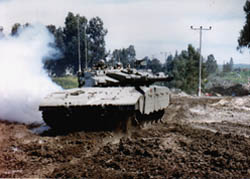
On 11 June, at the end of the first week of fighting, the brigade was at the suburbs of Beirut. Battalions 71 and 53 were at Duha, and battalion 74 at Kfar Sil. In the following days, the brigade fortified and organized itself to stay. At the same time, the terrorists returned fire on the Israeli forces. The units of the brigade advanced during this fighting and gained control of parts of the Beirut international airport in Hulda and the Science faculty building of the University of Beirut in Reihan. The brigade remained in Beirut for a month, during which the tasks to advance, fortify and organize were divided between the brigade and the Golani brigade.
On Monday, July 12th, the Barak units were transferred from the Beirut sector to the eastern sector. Battalion 74 remained in the coastal area, locating itself in the Damor area. The brigade was located opposite the Syrians in the Jib-Jenin-Sultan Ya'akub area. Ten days after arriving, the brigade participated in a battle in the area. This battle occurred after many Syrian violations of the cease fire, and after the Syrians permitted the terrorists to operate from their sector. The method selected was opening coordinated fire by all forces spread out along the length of the front line. The 53rd Battalion destroyed five Syrian tanks, and the 71st battalion destroyed about 30 tanks and armored combat vehicles.
A few days after this day of battle, during the night of August 3-4, the Barak units returned from Beka to the Beirut area. The IDF, including the Barak units, tightened the siege on western Beirut. IDF operations were simultaneous in two sectors - the north east sector of the city (the museum and the hippodrome) and the south west sector (the airport and surrounding suburbs of Jurj Barjina, Burj el Barajna, El-Uzai, Leilka and others). The Barak brigade participated in the military efforts on the second front. In the first stage, the brigade was active in capturing the airport runways, following earlier operations in this area during June-July during which very small advances on tens of meters each time were achieved. This advance was primarily carried out by the 74th battalion. In one of the battles in this area, the battalion commander was wounded, which resulted in the changing of the battalion with the 71st battalion. As the new battalion was taking its positions, it was attacked. Three of its soldiers were killed, including the commander of one of the companies, and many were injured. The Barak brigade continued its fighting in the area of the airport and the southern suburbs of west Beirut, until the terrorists left Beirut on August 31st.
The brigade remained in Lebanon, both in Beirut and in the eastern sector, for many months after the end of the Peace for Galilee war. After the return of the units to their permanent bases on the Golan Heights, they continued to alternately man the Lebanese border line for many more months.
From Israel Defense Force
_______________________________________________________________
Return to
TANKSIM.COM